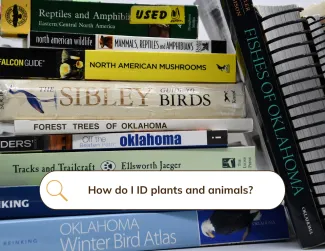
Identifying plants and animals can be a daunting but worthwhile endeavor. Building this skill can take years, calls for a lot of patience and attention to detail, and often leads to memorable – if not sometimes frustrating – time spent in nature. Thankfully, countless resources and identification tools are available that suit a variety of learning styles.
Field Guides
Printed field guides are a treasured part of many naturalists’ skill-building experience. They come in all shapes and sizes; may be hard cover, spiral bound, or foldable; feature illustrations or photographs; and include species found across continents, regions, or individual states. As for the “best” guide, it’s the one you will actually use. We recommend visiting a local library or bookstore to window-shop the best fit for you. If you plan on taking your guide afield, be sure to consider the weight and size … smaller, soft-bound copies often make for friendlier trail companions. (P.S. Used guides may come with a cheaper price tag and may include helpful notes from the previous owner!)
Online Resources
If you have a smartphone with a data plan, you’re already carrying an untold number of free guides and identification tools into the field. Online resources like oksnakes.org, the Cornell Lab of Ornithology’s All About Birds, and the U.S. Forest Service’s bumble bee guides often have more information than can be printed on the pages of a physical guide, and may include multimedia content like sound files and videos that simply can’t be printed.
Nature Apps
Many free nature sharing apps like iNaturalist and eBird include information about the species you’ve spotted, and some apps (we’re looking at you iNat) can actually provide identification recommendations when a photo is uploaded.
Beyond these sighting-oriented apps, a glut of nature apps and identification tools are waiting to be downloaded to your device. Some, like Merlin Bird ID by the Cornell Lab of Ornithology, are free, while others come with a nominal price tag. Apps like the Sibley Birds 2nd Edition combine features of printed field guides with the ability to search recordings and keep a personal log of your bird sightings.
Local Nature Organizations
If your preferred learning experiences come with a side of human connection, consider joining or attending a meeting of a local nature organization like the Audubon Society, Oklahoma Ornithological Society, Oklahoma Herpetological Society, or the Oklahoma Native Plant Society. These organizations often have member field trips that would give you a chance to explore Oklahoma and flex your identification skills.
Beyond nature-based organizations, many local and state parks have nature centers or host nature walks. One ready source of events like eagle watches or plant walks is travelok.com.
Sweat Equity
Whether you prefer printed field guides, online resources, or the human connection, you’ll need sweat equity to build your identification skills. That could come from setting a weekly routine of browsing a guide for 15 minutes, taking Merlin along for your morning coffee to test your bird song identification from your back porch, or making a daily or monthly trek to a local park or your favorite natural area. The more you test your identification skills, the more comfortable you’ll become with recognizing Oklahoma’s amazing plants and animals.